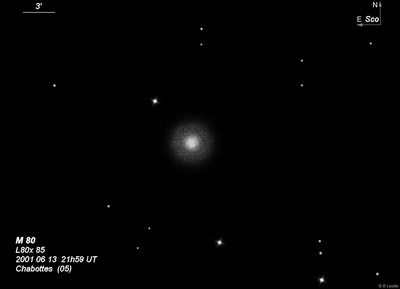
Charles Messier discovered M80 = NGC 6093 = h3624 on 4 Jan 1781. On 21 May 1784 (sweep 222), WH reported "a large cluster of exceedingly small and compressed stars, about 6 or 7' in dia; a great many of the stars are visible, the rest so small as to appear nebulous; those that are visible are of one size and are scattered all over equally. The cluster is of an iR form." On 24 May 1835 (sweep 588), John Herschel logged "Glob. Cl.; v m comp M; psvmbM; diam 12.0'; st = 14 m; all resolved. Fine object."
Arthur von Auwers discovered a nova (T Sco = Nova Scorpii 1860) in M80 on 21 May 1860 at Konigsberg Observatory. The magnitude was estimated between 6.5 and 7.0, as bright as the entire cluster. It was seen by N.R. Pogson on 28 May, while observing the variables R and S Sco, which share the same field. He reported being started by the appearance of a mag 7.6 star in the place of the cluster! Pogson assumed it was a new variable precisely along our line of sight to M80. T Sco is probably the first known variable star to be associated with a cluster.
200/250mm - 8" (7/5/83): a few faint stars resolved at moderate to high power at edges, very grainy, difficult to resolve.
300/350mm - 13" (7/5/83): contains a small intense unresolved core surrounded by fairly compact halo 5' diameter. The nucleus is offset to the east within the halo. The outer shell resolves into a few dozen faint stars over haze.
400/500mm - 17.5" (6/3/00): fairly bright, round, 5' diameter, well concentrated with a bright 1.5' core and an intense 30" nucleus. At 500x, the nucleus is clearly offset east of center and the outer halo is well resolved into at least 75 stars. A dim galaxy, IC 4596, lies 25' NW.
Notes by Steve Gottlieb